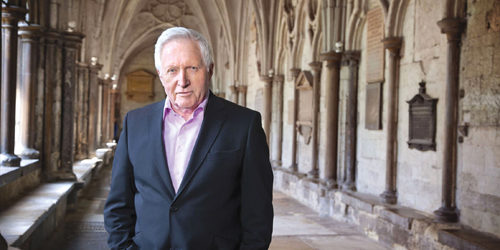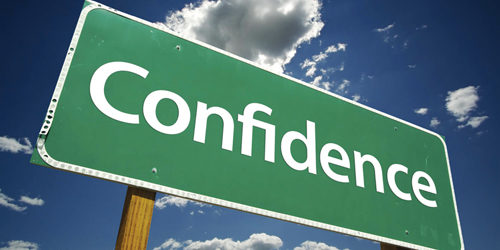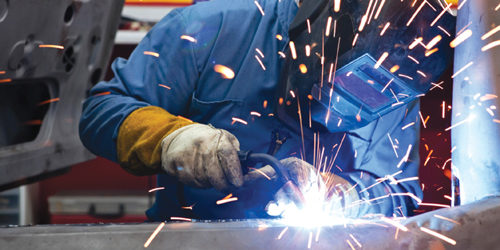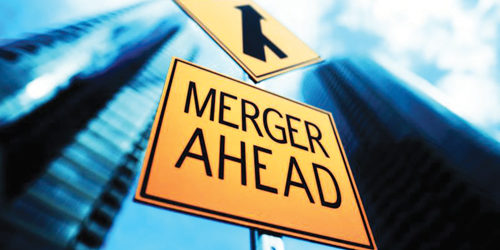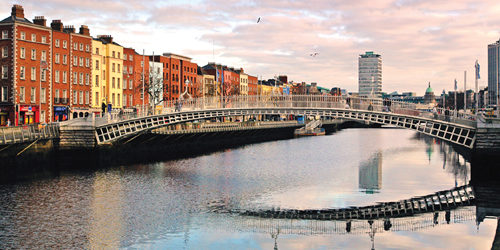
It’s my first visit to Dublin in ten years, and the circumstances are very different from last time.
As a student, I flew over on a Ryanair fight for the price of 1p (plus taxes) and spent a weekend barhopping around the cobbled streets in the Temple Bar area. This time, I dart between cosy cafés to escape the sheets of icy rain and warm up with steaming pots of tea. I take in the Dublin Writers’ Museum, the James Joyce Centre and the (surprisingly) enlightening National Leprechaun Museum for a holistic understanding of Ireland’s storytelling and literary culture, reflected in Dublin’s UNESCO City of Literature status.
I pour over the intricate letters of the 4th century Books of Kells, adorned with serpents, birds and golden Celtic knots, before basking in the spiritual serenity of Trinity College Library. All in all, a much more sedate visit, that leaves me with an appreciation of Dublin beyond ‘the craic’ and the creamy home-brewed Guinness (it just doesn’t taste the same on this side of the Irish Sea…).
Ireland’s contribution to international culture is undeniable. The legacy of its literary, musical and historical heroes is woven into the fabric of its capital city, which generates a sparky, inspiring atmosphere for hosting MICE (meetings, incentives, conferences and events).
Central Dublin’s charming Georgian architecture and small size are both appealing attributes for hosting large-scale conferences. In terms of hotel stock, the city may not have an abundance of new properties, but instead, its 20,000 rooms are continually being refreshed. “Every one of our hotels has gone through some sort of refurbishment programme over the past few years,” says Sam Johnston, Manager of the Dublin Convention Bureau. “And the convention centre is just under seven years old, but it looks as if it opened yesterday”.
Nestled in the heart of Dublin Docklands, Convention Centre Dublin’s semi-cylindrical glass facade offers views of the green hills beyond the city limits. Its cutting-edge design and facilities, including a 2,000-seat auditorium, 4,500 sqm of exhibition space and 22 meeting rooms, earned it the accolade of the ‘World’s Best Overseas Conference Venue’ at the 2015 C&IT Awards. And, last year, Dublin hosted some 150 conferences (including heavyweights such as the International Air Transport Association’s AGM in June) totalling approximately €67 million for Ireland’s economy.
When it comes to business, Dublin has spent time building on its strengths and cultivating growth in certain sectors, including fintech, aviation leasing and support services (law and accountancy firms). Facebook’s European HQ is here – the 12.5 percent corporate tax rate no doubt an attraction. Situated along Dublin Docklands, the company is based in a Daniel Libeskind designed building, fitted out with Frank Gehry interiors, said to reflect a “work-in-progress atmosphere”.
Dublin International airport is only a short hop away for continental passengers, and its connectivity to more than 179 destinations is a huge pull factor for business travel. “We connect to all the major European hubs, then you land at Dublin airport and you’re in the city in 15-20 minutes,” says Johnston. “So we’re easy to reach for Europe-based travellers, and they won’t need to take too many days out of their schedule”.
A year on since Britain voted for Brexit, it’s still difficult to move beyond speculation as to what leaving the European Union will mean for the Emerald Isle, although a hard Brexit would be disruptive. When the Northern Irish border becomes the only land border between the European Union and the UK (depending on Scotland’s decision to hold another referendum for independence) there has been talk of Britain potentially introducing its own immigration controls to Irish airports – already met with outrage by Irish citizens, as the current open barrier not only benefits those who work and live on opposite sides of the border, but plays a part in protecting the peace after decades of conflict.
Regarding trade, the UK is Ireland’s third biggest export destination, accounting for 12% of total exports after the US (22%) and Belgium (13%). Meanwhile, Britain is Ireland’s largest importer, responsible for 28% of total imports. At the time of going to press, the ‘snap’ general election was still one month away. Whoever the prime minister is after June 8th, the better trade deal they are able to secure with the EU, the better for Ireland’s economy.
On the other hand, certain financial companies are reportedly sizing up Dublin for their new post-Brexit European headquarters, including Barclays and Standard Chartered PLC, and in August, a survey from Price Waterhouse Cooper placed Dublin second after London among Europe’s most appealing financial centres. According to a joint report by the Royal Institution of Chartered Surveyors and the Society of Chartered Surveyors Ireland, property agents have seen a 30% increase in the number of enquiries from UK firms looking to relocate and protect their access to the single market.
At the same time, in March, Ireland issued a formal complaint to the European Commission, stating that other EU cities weren’t playing fair in the scramble to attract financial firms spooked by Brexit – Eoghan Murphy, Ireland’s Financial Services Minister was reported as saying that certain cities were being “very aggressive in trying to win business”. He added that rather than “brass-plating”, Dublin expects “the mind and management of the entity” to be in Ireland. It seems that Dublin is not content with merely playing host to financial firms leaving London, and instead, any arriving companies will need to fully integrate into its business ecosystem.
Wander down to Docklands – the sleek modernity of its architecture redolent of Canary Wharf – and you’ll see a number of cranes poised to add to Dublin’s already impressive infrastructure. Recently, plans were approved for a €700 million development, Dublin Landings. Covering more than two hectares, it will encompass five office buildings, 273 apartments and retail space when it opens in 2020. From here, about halfway towards the Temple Bar Area, another mega project is underway. Tara House will become the tallest building in Dublin at 88 metres-high, housing a 110-room hotel, a five storey viewing podium and a top floor restaurant and bar. The intention is for it to act as a “landmark gateway” between Dublin’s historic centre and the modernism of Docklands.
Dublin’s heritage may be rich, but its future is also looking prosperous. If in the financial firms do choose to relocate to the Irish capital, a smorgasbord of immaculate new facilities and a business-friendly climate will be ready and waiting to receive them.
TOP PLACES FOR A MEETING/EVENT
POWERSCOURT HOTEL
Situated in Wicklow - 45 minutes from Dublin - this striking crescent-shaped hotel sits within a verdant estate owned by the Slazenger family. Part of Marriott International’s Autograph Collection, the elegant 194 room property shares it surrounds with two championship golf courses and Ireland’s highest waterfall.
powerscourthotel.com
GUINNESS STOREHOUSE
The home of the ebony nectar would make a memorable event venue. The entire building can be hired for 2,000 guests, and for banquets, it’s possible to arrange for a menu made entirely with Guinness ingredients.
guinness-storehouse.com
CROKE PARK
For a unique team building activity, organise a game of Gaelic football at Croke Park – the national stadium for Gaelic games - which also has its own conference centre.
crokepark.ie
TEELING WHISKEY DISTILLERY
This operational factory offers industrial chic event space, with the option to arrange tours and tasting sessions.
teelingwhiskey.com
WHERE TO STAY
CONRAD DUBLIN
Reopened in March last year after an extensive refurbishment, this smart five star property is located opposite Dublin’s National Concert Hall. Its light-hued rooms feature Irish artwork, free wifi and Nespresso machines. There’s also a 350 capacity ballroom, a brasserie serving locally inspired dishes.
conradhotels.hilton.com
THE MARKER
A member of the Leading Hotels of the World, the Marker offers unconventional design features throughout its 187 rooms and suites, as well as views across the city from its Docklands location. Its trendy rooftop bar and terrace is available for hire, and its sleek spa has a masculine feel.
themarkerhoteldublin.com
TRINITY CITY HOTEL
Located bang in the centre of Dublin, this quirky four star hotel has colourful rooms and suites, some of which feature Georgian era decor. There are two attractive spaces for boardroom style meetings - land a grassy courtyard, where it’s possible to host outdoor events.
trinitycityhotel.com



